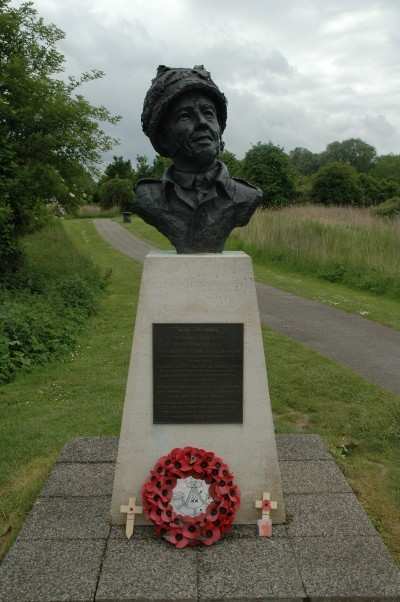The Remarkable Airspeed Horsa
By ANN Senior Correspondent Kevin "Hognose" O'Brien
Read Part One
(This is the second in a three-part ANN special report on
the gliders that carried Allied troops to Europe during the D-Day
invasion of June 6th, 1944. Part Three Runs Thursday. --
ed.)
The Airspeed Horsa wasn't just any glider. Designed and
prototyped in haste, made mostly of plywood, with sections
manufactured by furniture makers and then assembled by the Airspeed
firm, best known for light planes and trainers, it was a near DC-3
sized cargo truck of the air. The most common glider in the
invasion was the Waco CG-4B which the British called "Hadrian." The
CG-4B reminds you of an overgrown Cub: it's made of tube and
fabric, and built as lightly, and cheaply, as possible. The Horsa
reminds you of a plywood Hollywood mockup, built to be thrown away,
but large.

The Horsa glider had tricycle landing gear that you were
supposed to use only for takeoff, and then jettison -- it landed on
the nosewheel and a stout wooden skid. Speed could be reduced a
little, and descent steepened a lot, by gargantuan flaps. With no
need for fuel tanks in the wings, the wing roots were home to
equipment storage where the glider troops could stash all kinds of
goodies -- heavy weapons, explosives, supplies, radios. The bottom
skin of the glider's wing opened up almost like bomb-bay doors to
allow these to be loaded and unloaded.
That skin, like almost all the machine's structure, was made of
plywood with the barest minimum of metal fittings. The floor was
reinforced, but the fuselage skin was deliberately made light
enough that a trooper trapped inside could kick through it. A stout
plywood bulkhead behind the pilots would protect them from cargo
that shifted on landing --with a little luck. A large door in the
port side of the fuselage behind the cockpit provide ingress and
egress, and large loads like Jeeps (which needed some small
modifications, like trimming the bumpers, to fit) or field guns
were taken out the back -- removing four bolts let the tail cone
fall off, and not only the pilots but passengers had trained to do
that.

The Horsa was capable of carrying a wide variety of loads. This
rare "load planner" (photo) was a custom -- patented! -- set of
balances that were used in arranging cargo loads so that the Horsa
remained within its CG range. The pilots sat side-by-side in a
glazed cockpit, flying the glider with floor-mounted yokes. Their
tiny instrument panel was set in between them. Inside the glider,
the pilots worked, while the troops in the back waited, and
worried. The sound of the tow plane was somewhat distant; the
loudest sound was already rushing air. Most of the soldiers sang
songs to pass the time, or joked. Some slept. The officers and NCOs
ran over the plans in their heads.

The commander of the operation, Major John Howard of D Co 2nd
Battalion Oxford and Buckinghamshire Light Infantry ("Ox and Bucks"
-- memorialized at Pegasus Bridge, below), crouched behind the
glider pilots and watched the target get closer. They would release
at 6,000 feet. In twelve hours or less, he and his mean would be
relieved by the commandos, and would be heroes... or they wouldn't,
and they'd be dead, or captives. The Nazis, every man in the
gliders knew, were inconsistent about taking airborne troops
prisoner. Captivity might be very brief and unhappy.

How Much Landing Run Do You Need?
The Germans were keenly aware of the glider threat and looked
out for likely landing spots, which they then despoiled with large
posts like telephone poles, designed to tear the gliders apart --
or deny them that landing zone. Sometimes their creativity extended
to putting land mines or explosive charges on top of the poles, or
wiring them with barbed-wire guy wires.
But even with a whole continent enslaved, you can't put poles up
in every field overnight. So they started with the largest ones and
were working their way down. The Germans had their own gliders and
knew how they performed. After all, a landing on too short a field
wouldn't be logical.
The Landing Zones on the left flank of the invasion were so
small that there was no chance at all for a safe landing, unless
you were willing to land some distance away and then move overland
-- through the areas the Germans had occupied for years -- to the
bridges. There were fields right by the bridges but they were only
a couple of hundred yards long. Far too small for a safe
landing.
But the planners had seen a number of glider crashes, and they
had been surprised about how well the troops came out of even
spectacular pile-ups. What about a controlled crash, as near to the
bridge as possible? Most of the men should survive. And they would
know what they were about. The Germans would be shocked, because
this was going to be the very first landing. This plan best
preserved the glider's native stealth.

The planners believed that they were sending many men to their
deaths, but with three gliders, each with an officer who fully
understood the mission, and with all men completely briefed on the
target -- they had been attacking a mock-up for weeks -- they
expected that enough would survive to take and hold the bridges
until the commandos could make it overland from Ouistreham at Juno
Beach.
The officers and men in the gliders knew all about these
expectations. Despite that, they crossed the channel singing. Or
perhaps it was because of that.
 ANN's Daily Aero-Linx (04.13.24)
ANN's Daily Aero-Linx (04.13.24) ANN's Daily Aero-Term (04.13.24): Beyond Visual Line Of Sight (BVLOS)
ANN's Daily Aero-Term (04.13.24): Beyond Visual Line Of Sight (BVLOS) Airborne 04.09.24: SnF24!, Piper-DeltaHawk!, Fisher Update, Junkers
Airborne 04.09.24: SnF24!, Piper-DeltaHawk!, Fisher Update, Junkers Aero-News: Quote of the Day (04.14.24)
Aero-News: Quote of the Day (04.14.24) ANN's Daily Aero-Term (04.14.24): Maximum Authorized Altitude
ANN's Daily Aero-Term (04.14.24): Maximum Authorized Altitude







